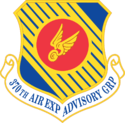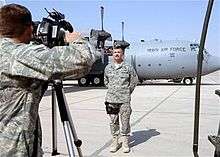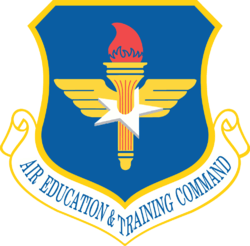370th Air Expeditionary Wing
| 370th Air Expeditionary Wing | |
|---|---|
|
The unit activation and assumption of command of the 370th Air Expeditionary Advisory Group and Squadron took place at New Al Muthana Air Base April 22, 2007 | |
| Active |
1934 1937–1944 2007–2008 |
| Country |
|
| Branch |
|
| Role | Training |
| Part of | 9th Aerospace Expeditionary Task Force |
| Motto(s) | Alatum Servitium – "Winged Service" |
| Insignia | |
| 370th Air Expeditionary Advisory Group emblem |
 |
The 370th Air Expeditionary Wing (AEW) is a provisional United States Air Force unit assigned to United States Air Forces Central, which may activate or inactivate it at any time. The unit was last stationed in Iraq, and was likely inactivated in 2011 as part of the United States pullout of forces.
History
Pre World War II
The 370th Air Expeditionary Wing was originally constituted as the 1st Transport Group in 1933.[1] As a Regular Army Inactive unit, it was assigned reserve personnel in early 1934 only for training purposes.[2] From February to May 1934, the group was provisionally organized at Columbus, Ohio.[2]
In 1937, the group was consolidated with the 10th Observation Group, also constituted in 1933 but never activated. The consolidated group was designated the 10th Transport Group and activated on 20 May 1937.[1] Its original squadrons were the 1st,[3] 2d,[4] 3d,[5] and 4th Transport Squadrons.[6] It provided a single headquarters for these squadrons, which had been assigned to the various Air Depots in the United States.[3][4][5][6] The group headquarters and one of its squadrons were located at what is now Wright-Patterson Air Force Base, Ohio. It operated single-engine Bellanca C-27 Airbus and twin-engine Douglas C-33 transports as part of the logistics organization of the Air Corps on routes in the US and to Alaska and the Canal Zone, transporting supplies, materiel, and personnel.[1]
In May 1941, two of the group's squadrons were reassigned to provide cadres for newly forming transport groups as the Air Corps expanded. The 3d Transport Squadron was reassigned to the 63d Transport Group,[5] while the 4th Transport Squadron was reassigned to the 62d Transport Group[6] This left the group with two of its original squadrons, plus the 5th Transport Squadron, which had activated under the group in 1939.[7]
World War II

On April 30, 1942 the group transferred to the Air Transport Command (later I Troop Carrier Command) (I TCC) and was redesignated as the 10th Troop Carrier Group two months later.[1] It converted primarily to Douglas C-47 Skytrain aircraft, but also flew other military models of the Douglas DC-3.[8] After its transfer the group acted as an Operational Training Unit (OTU), OTUs were oversized units that trained cadres for "satellite" troop carrier groups.[9] In 1943 the group was given the additional duty of acting as a Replacement Training Unit training replacement aircrews.[1] In February 1943, the last of the group's original squadrons, the 1st and 2d Troop Carrier Squadrons (TCS) deployed to the CBI Theater and were assigned to Tenth Air Force.[3][4] The following month, they were replaced by the 307th and 308th TCSs.[10] During the next two years, the group moved frequently to various I TCC stations, while its squadrons were frequently located elsewhere.[7] All squadrons except for the 38th TCS, located at Laurinburg-Maxton Army Air Base, North Carolina[11] were colocated with group headquarters by early 1944.[1][7][10]
The Army Air Forces found that standard military units, based on relatively inflexible tables of organization were proving less well adapted to performing the training mission. Accordingly, a more functional system was adopted in which each base was organized into a separate numbered unit.[12] As a result, the 10th was disbanded in April 1944[1] and its mission, personnel, and equipment were combined with the support organizations at Alliance Army Air Field and transferred to the 805th AAF Base Unit (Replacement Training Unit, Troop Carrier),[13] while that of the 38th TCS was transferred to the 810th AAF Base Unit (Combat Crew Training School, Troop Carrier).
Expeditionary Service

The 370th Air Expeditionary Advisory Group (AEAG) was activated as part of the Global War On Terror on 29 March 2007. Its activation ceremony at New Al Muthana Air Base was delayed until late April.[14] The mission of the 370 AEAG was to restart the Iraqi Air Force by training Iraqi Air Force aircrews how to operate, employ and maintain Lockheed C-130 Hercules and Mil Mi-17[15] aircraft, and to maintain and operate as a self-sufficient air base. This mission was known as "CAFTT" for Coalition Air Forces Training Team.[15] The unit was made up of Airmen from a variety of career specialties and it was assigned to Second Air Force as part of Air Education and Training Command. The 370 AEAG was made up of Airmen from a variety of career fields.[15]
Lineage

10th Observation Group
- Constituted on the inactive list as 10th Observation Group on 1 October 1933 (never active)
- Consolidated with the 1st Transport Group as the 10th Transport Group on 20 May 1937
370th Air Expeditionary Wing
- Constituted on the inactive list as 1st Transport Group on 1 October 1933[16]
- Organized provisionally on 14 February 1934
- Discontinued as a provisional organization on 11 May 1934
- Consolidated with the 10th Observation Group as the 10th Transport Group, and activated, on 20 May 1937[17]
- Re-designated as: 10th Troop Carrier Group in July 1942.
- Disbanded on 14 April 1944.
- Reconstituted and re-designated 370th Military Airlift Group on 31 July 1985[8]
- Re-designated 370th Air Expeditionary Group and converted to provisional status on 24 October 2005[8]
- Re-designated 370th Air Expeditionary Advisory Group on 23 March 2007[8]
- Activated on 29 March 2007[8]
- Inactivated on 1 November 2008[18]
- Re-designated 370th Air Expeditionary Wing on 25 February 2010[19]
- Inactivated 2011
Assignments
- 6th Transport Wing, 14 February 1934 – 11 May 1934
- Office of Chief of the Air Corps, 20 May 1937
- 50th Transport Wing 4 January 1941
- 52d Troop Carrier Wing, 4 October 1942
- I Troop Carrier Command, 13 February 1943 – 14 April 1944
- Air Education and Training Command to activate or inactivate any time after 23 March 2007 (Attached to: United States Air Forces Central)
- 9th Air Expeditionary Task Force, 29 March 2007 – 1 November 2008
Components
Airlift Squadrons
|
|
Support Units
|
|
Stations
|
|
Aircraft
- Bellanca C-27 Airbus, 1937
- Douglas C-33, 1937–1939
- Douglas C-39, 1938–1942
- Douglas C-47 Skytrain, 1942–1944
- Douglas C-48, 1942
- Douglas C-53 Skytrooper, 1942–1944
- Lockheed C-130 Hercules, 2007–2008
- Aeronca L-3 Defender, 1943
Gliders
- Waco CG-4, 1943–1944
- Airspeed Horsa, 1943–1944
References
Notes
- 1 2 3 4 5 6 7 Maurer, Maurer, ed. (1983) [1961]. Air Force Combat Units of World War II (PDF) (reprint ed.). Washington, DC: Office of Air Force History. pp. 52–53. ISBN 0-912799-02-1.
- 1 2 Clay, Steven E. (2010). U.S. Army Order of Battle, 1919–1941 (PDF). 3, The Services: Air Service, Engineers, and Special Troops, 1919–41. Fort Leavenworth, KS: Combat Studies Institute Press. p. 1296. ISBN 9780984190140. LCCN 2010022326. OCLC 637712205. Retrieved 27 November 2012.
- 1 2 3 Maurer, Maurer, ed. (1982) [1969]. Combat Squadrons of the Air Force, World War II (PDF) (reprint ed.). Washington, DC: Office of Air Force History. pp. 9–10. ISBN 0-405-12194-6.
- 1 2 3 4 Maurer, Combat Squadrons, pp. 17–18
- 1 2 3 4 Maurer, Combat Squadrons, p. 25
- 1 2 3 4 Maurer, Combat Squadrons, pp. 31–32
- 1 2 3 Maurer, Combat Squadrons, p. 37
- 1 2 3 4 5 AFHRA Factsheet, 370th Air Expeditionary Advisory Group (retrieved Nov 27, 2012)
- ↑ Craven, Wesley F; Cate, James L, eds. (1955). "Introduction". The Army Air Forces in World War II. Vol. VI, Men & Planes. Chicago, IL: University of Chicago Press. p. xxxvi. LCCN 48-3657.
- 1 2 Maurer, Combat Squadrons, pp. 372–374
- ↑ Maurer, Combat Squadrons, pp. 181–182
- ↑ Goss, William A (1955). "The Organization and its Responsibilities, Chapter 2 The AAF". In Craven, Wesley F; Cate, James L. The Army Air Forces in World War II. Vol. VI, Men & Planes. Chicago, IL: University of Chicago Press. p. 75. LCCN 48-3657.
- ↑ Abstract, History of Alliance AAF Apr–Jun 1944 (retrieved Nov 27, 2012)
- ↑ Air Force Print News Story: 370th Group and squadron stand up, 22 Apr 2007 (retrieved Nov 28, 2012)
- 1 2 3 4 332nd Air Expeditionary Wing Press Release, Airmen help Iraqi air force become self-sustaining service, 9 June 2008 (retrieved 28 Nov, 2012)
- ↑ Not related to the 1st Transport Group, which was activated as the 1st Ferrying Group and served in India during World War II
- ↑ Not related to the 10th Transport Group, which was activated as the 10th Ferrying Group and served in the Caribbean during World War II
- 1 2 3 4 5 Air Force Organization Status Change Report, November 2008 (available at Research Division, Air Force Historical Research Agency)
- ↑ Air Force Organization Status Change Report, February 2010 (available at Research Division, Air Force Historical Research Agency)
- 1 2 3 4 5 6 At various I TCC stations after 1942
- ↑ AFHRA Factsheet, 2d Airlift Squadron (retrieved Nov 27, 2012)
- ↑ AFHRA Factsheet, 4th Airlift Squadron (retrieved Nov 27, 2012)
- ↑ Maurer, Combat Squadrons, pp. 140–141
- ↑ AFHRA Factsheet, 38th Airlift Squadron (retrieved Nov 27, 2012)
- ↑ Clay, p. 1366
Bibliography
![]() This article incorporates public domain material from the Air Force Historical Research Agency website http://www.afhra.af.mil/.
This article incorporates public domain material from the Air Force Historical Research Agency website http://www.afhra.af.mil/.
- Clay, Steven E. (2010). U.S. Army Order of Battle, 1919–1941 (PDF). 3, The Services: Air Service, Engineers, and Special Troops, 1919–41. Leavenworth, KS: Combat Studies Institute Press. ISBN 9780984190140. Retrieved 27 November 2012.
- Craven, Wesley F; Cate, James L, eds. (1955). The Army Air Forces in World War II. Vol. VI, Men & Planes. Chicago, IL: University of Chicago Press. LCCN 48-3657.
- Maurer, Maurer, ed. (1983) [1961]. Air Force Combat Units of World War II (PDF) (reprint ed.). Washington, DC: Office of Air Force History. ISBN 0-912799-02-1. LCCN 61060979.
- Maurer, Maurer, ed. (1982) [1969]. Combat Squadrons of the Air Force, World War II (PDF) (reprint ed.). Washington, DC: Office of Air Force History. ISBN 0-405-12194-6. LCCN 70605402. OCLC 72556.
- Mueller, Robert (1989). Air Force Bases, Vol. I, Active Air Force Bases Within the United States of America on 17 September 1982 (PDF). Washington, DC: Office of Air Force History. ISBN 0-912799-53-6.

